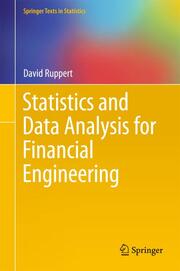-
Zusatztext
-
<div style="MARGIN: 0in 0in 0pt; LINE-HEIGHT: normal">Financial engineers have access to enormous quantities of data but need powerful methods for extracting quantitative information, particularly about volatility and risks. Key features of this textbook are: illustration of concepts with financial markets and economic data, R Labs with real-data exercises, and integration of graphical and analytic methods for modeling and diagnosing modeling errors. Despite some overlap with the author's undergraduate textbook <em>Statistics and Finance: An Introduction</em>, this book differs from that earlier volume in several important aspects: it is graduate-level; computations and graphics are done in R; and many advanced topics are covered, for example, multivariate distributions, copulas, Bayesian computations, VaR and expected shortfall, and cointegration. </div> <div style="MARGIN: 0in 0in 0pt; LINE-HEIGHT: normal">The prerequisites are basic statistics and probability, matrices and linear algebra, and calculus.</div> <div style="MARGIN: 0in 0in 0pt; LINE-HEIGHT: normal">Some exposure to finance is helpful.</div>
-
-
Kurztext
-
Financial engineers have access to enormous quantities of data but need powerful methods for extracting quantitative information, particularly about volatility and risks. Key features of this textbook are: illustration of concepts with financial markets and economic data, R Labs with real-data exercises, and integration of graphical and analytic methods for modeling and diagnosing modeling errors. Despite some overlap with the author's undergraduate textbook Statistics and Finance: An Introduction, this book differs from that earlier volume in several important aspects: it is graduate-level; computations and graphics are done in R; and many advanced topics are covered, for example, multivariate distributions, copulas, Bayesian computations, VaR and expected shortfall, and cointegration. The prerequisites are basic statistics and probability, matrices and linear algebra, and calculus. Some exposure to finance is helpful. David Ruppert is Andrew Schultz, Jr., Professor of Engineering and Professor of Statistical Science, School of Operations Research and Information Engineering, Cornell University, where he teaches statistics and financial engineering and is a member of the Program in Financial Engineering. His research areas include asymptotic theory, semiparametric regression, functional data analysis, biostatistics, model calibration, measurement error, and astrostatistics. Professor Ruppert received his PhD in Statistics at Michigan State University. He is a Fellow of the American Statistical Association and the Institute of Mathematical Statistics and won the Wilcoxon prize. He is Editor of the Electronic Journal of Statistics, former Editor of the Institute of Mathematical Statistics's Lecture Notes--Monographs Series, and former Associate Editor of several major statistics journals. Professor Ruppert has published over 100 scientific papers and four books: Transformation and Weighting in Regression, Measurement Error in Nonlinear Models, Semiparametric Regression, and Statistics and Finance: An Introduction.
-
Detailansicht
Statistics and Data Analysis for Financial Engineering
Springer Texts in Statistics
ISBN/EAN: 9781461427490
Umbreit-Nr.: 4249457
Sprache:
Englisch
Umfang: xxii, 638 S.
Format in cm:
Einband:
kartoniertes Buch
Erschienen am 02.01.2013
Auflage: 1/2014


